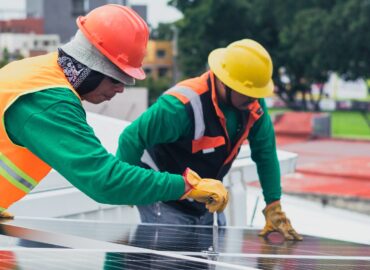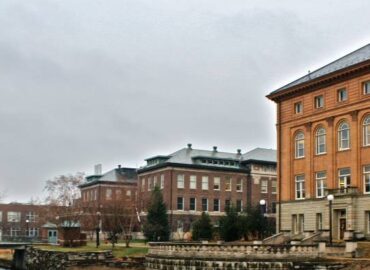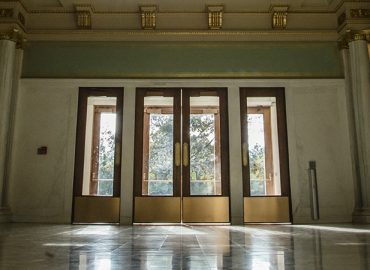On a cool and sunny spring afternoon in Central Illinois, students from the University of Illinois at Urbana-Champaign (UIUC) Sustainable Design program and others studying Landscape Architecture and Energy Systems Sciences participated in a field trip to solar project sites in Urbana-Champaign. The tour was sponsored by the Fine and Applied Arts Sustainable Design Program and organized by SEDAC to provide an up-close chance for students to learn about the design and development of different solar technology applications. The solar tour included five locations: the UIUC Solar Farm 1, a residence with roof-top solar, the Urbana Park District’s Anita Purves Nature Center, the Nexamp community solar array on the closed Urbana landfill, and Riggs Brewery.
“Before this tour, I don’t think I really understood how solar actually works. Like how you figure out if it is economically viable, who you contact, what kind of different models you can do, and what solar is like on different scales for residential, business or a large-scale project serving thousands of people.”
Oriya Falk, Senior in Sustainable Design

UIUC Solar Farm 1. Sushanth Girini, UIUC Facilities and Services Management Engineer, led the first site tour of the day. Solar Farm 1 is a 21-acre large solar array near the University of Illinois Research Park. It generates enough energy to cover about 2% of the campus’ electricity needs. The system was designed, built, and is now operated by Phoenix Solar South Farms, LLC through a power purchase agreement with UIUC. Girini described the work he does to maintain the solar farm and its tie-in to the University of Illinois energy grid. Some of this maintenance includes monitoring and replacement of failed connectors and landscape maintenance needed to maximize solar production.
Home Rooftop Solar. In contrast to the utility-scale university solar farms, the second stop was a visit to the small-scale 11 kW roof-mount PV system that provides about 80% of the electricity for Andy Robinson’s home. With net metering, the electricity that the PV system generates during the day is used by the home; excess energy is provided to the electric grid in exchange for credits that can be redeemed when the output of the array is less than the home requires, such as at night. Net metering by Ameren allows these credits to be carried from month-to-month up to a year.
As an avid supporter of renewable energy, Mr. Robinson has given many solar energy seminars for the Urbana-Champaign GrowSolar Solar Group Buy program. He is also a UIUC Retro-commissioning Management Engineer whose day-to-day job involves improving building energy efficiency on campus, helping the university save millions of dollars in reduced energy costs.


Urbana Parks District Anita Purves Nature Center. The tour continued at the Urbana Parks District (UPD) Anita Purves Nature Center. The nature center serves 50,000 visitors a year. Recently, the park district added a parking lot along with a new pavilion and education space. UPD applied for grants to include solar powered parking lot lights with dimming and occupancy controls. Andy Rousseau, UPD Project Manager, shared his experiences and insights into the ways that solar renewable energy plays a role in the mission of Urbana’s parks. One unique opportunity they have identified is to provide solar powered wireless internet access within parks that can be used by the public. The park district plans to incorporate solar energy into future construction projects as a wholistic strategy of high performance buildings.
Community Solar on Urbana’s Closed Landfill. The fourth stop of the day featured Nexamp’s Community Solar Farm developed on top of the City of Urbana’s closed landfill. Unlike traditional solar farms where the ground-mounted racking system has supporting poles that are drilled into the ground, this system features a ballasted racking/mounting system along with suspended electrical cabling to ensure that the clay cap of the landfill is not compromised. Scott Tess, Sustainability and Resilience Officer for the City of Urbana, provided an energetic tour and students were inspired to think out-of-the-box when they saw that a closed landfill can be repurposed into a solar farm.

“I’m taking a few architecture classes, and we’re focusing on sustainable buildings. And until now, we just put on solar panels, like, okay, the roof has solar panels, and it makes the building sustainable. But then looking and listening from everybody’s experience, it’s not just installing solar panels that makes a building or project sustainable, there’s a long process that goes behind it…This opened up a perspective that I didn’t think of before.”
Maitri Gandhi, freshman in Sustainable Design
Solar at Riggs Brewery. The solar tour concluded with a visit with Matt Riggs of Riggs Beer Company. We sat under a solar pergola on the brewery’s back porch and learned about Riggs’ experiences with farming and running a brewery Illinois. Riggs farms barley, wheat, and corn for their beer brewing operation.
Nearly 90 percent of the brewery’s electricity needs are met with solar electricity produced on the property. A large south-facing ground-mount array at the edge of the parking lot and the solar pergolas provide electricity for the main property. The pergolas provide a shaded area for customers to enjoy local brews and the community atmosphere out of the sun on hot summer days. Net metering, federal tax credits, and Illinois Solar Renewable Energy Credits make the financial model for solar attractive to businesses and investors.
“My favorite part of the tour was getting to hear local people’s opinions about sustainability in the world. On top of that, it’s nice to get off-campus; it can feel very enclosed, just wake up, do academics, whatever else you do in your free time. There’s a world outside of that.”
Benjamin Dushman, Sophomore in Sustainable Design





